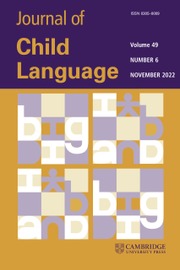Crossref Citations
This article has been cited by the following publications. This list is generated based on data provided by
Crossref.
Leonard, Laurence B.
Schwartz, Richard G.
Folger, M. Karen
Newhoff, Marilyn
and
Wilcox, M. Jeanne
1979.
Children's Imitations of Lexical Items.
Child Development,
Vol. 50,
Issue. 1,
p.
19.
Hart, Betty
1980.
Advances in Clinical Child Psychology.
p.
383.
Fay, Warren H.
and
Anderson, Daryl E.
1981.
Children's Echo-Reactions as a Function of Increasing Lexical Difficulty: A Developmental Study.
The Journal of Genetic Psychology,
Vol. 138,
Issue. 2,
p.
259.
Garvey, Catherine
and
Berninger, Ginger
1981.
Timing and turn taking in children's conversations1.
Discourse Processes,
Vol. 4,
Issue. 1,
p.
27.
Kuczaj, Stan A.
1982.
Advances in Child Development and Behavior Volume 17.
Vol. 17,
Issue. ,
p.
197.
HARRIS, JOHN
1983.
What Does Mean Length of Utterance Mean? Evidence From a Comparative Study of Normal and Down's Syndrome Children*.
International Journal of Language & Communication Disorders,
Vol. 18,
Issue. 3,
p.
153.
Klecan-Aker, Joan S.
Domico, William D.
and
Bothwell, Kathleen
1983.
A Clinical Taxonomy for the Categorization of Language Functions Used By School-Age Children in a Structured Setting.
Language and Speech,
Vol. 26,
Issue. 2,
p.
131.
Ting‐Toomey, Stella
1983.
Coding conversation between intimates: A validation study of the intimate negotiation coding system (INCS).
Communication Quarterly,
Vol. 31,
Issue. 1,
p.
68.
Dobrich, Wanda
and
Scarborough, Hollis S
1984.
Form and function in early communication: Language and pointing gestures.
Journal of Experimental Child Psychology,
Vol. 38,
Issue. 3,
p.
475.
Ferrell, Kay A.
1984.
Early Years Action Plan.
Journal of Visual Impairment & Blindness,
Vol. 78,
Issue. 2,
p.
56.
Scherer, Nancy J .
and
Owings, Nathaniel O.
1984.
Learning to be Contingent: Retarded Children's Responses To Their Mothers' Requests.
Language and Speech,
Vol. 27,
Issue. 3,
p.
255.
Olswang, Lesley B.
and
Coggins, Truman E.
1984.
The effects of adult behaviours on increasing language delayed children's production of early relational meanings.
International Journal of Language & Communication Disorders,
Vol. 19,
Issue. 1,
p.
15.
McLean, Mary
and
Vincent, Lisbeth
1984.
The Use of Expansions as a Language Intervention Technique in the Natural Environment.
Journal of the Division for Early Childhood,
Vol. 9,
Issue. 1,
p.
57.
Klecan-Aker, Joan S.
and
Lopez, Beth
1984.
A clinical taxonomy for the categorization of pragmatic language functions in normal preschool children.
Journal of Communication Disorders,
Vol. 17,
Issue. 2,
p.
121.
Klecan-Aker, Joan S.
and
Lopez, Beth
1984.
A Comparison of Language Functions Used By Normal Male and Female Pre-School Children in a Structured Setting.
Journal of Childhool Communication Disorders,
Vol. 7,
Issue. 2,
p.
4.
Kekelis, Linda S.
and
Andersen, Elaine S.
1984.
Family Communication Styles and Language Development.
Journal of Visual Impairment & Blindness,
Vol. 78,
Issue. 2,
p.
54.
Moerk, Ernst L.
1985.
Analytic, synthetic, abstracting, and word-class-defining aspects of verbal mother-child interactions.
Journal of Psycholinguistic Research,
Vol. 14,
Issue. 3,
p.
263.
Bell, Ian
1985.
Communication and language in mental handicap.
Journal of the British Institute of Mental Handicap (APEX),
Vol. 13,
Issue. 3,
p.
105.
Bell, Ian
1985.
Communication and language in mental handicap.
Journal of the British Institute of Mental Handicap (APEX),
Vol. 13,
Issue. 2,
p.
65.
Casby, Michael W.
1986.
A pragmatic perspective of repetition in child language.
Journal of Psycholinguistic Research,
Vol. 15,
Issue. 2,
p.
127.

